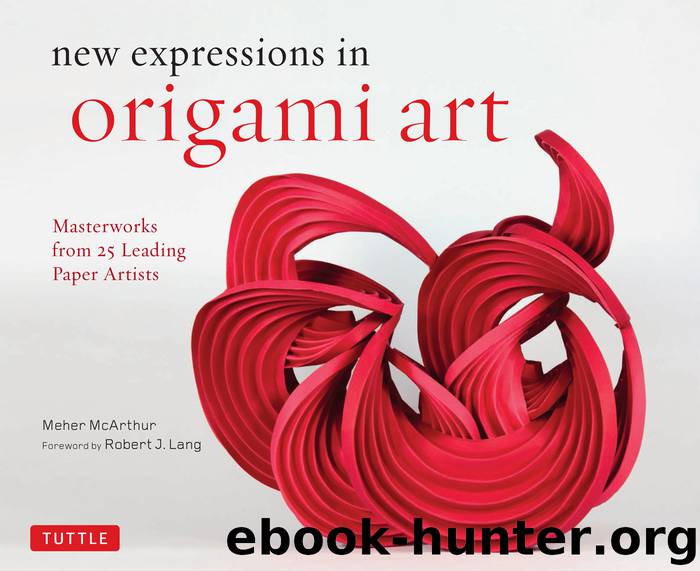New Expressions in Origami Art by Meher McArthur

Author:Meher McArthur
Language: eng
Format: epub
ISBN: 978-0-8048-4677-6
Publisher: Tuttle Publishing
Dancing Crane, Opus 460
Robert J. Lang, USA 2005, one uncut square of Korean hanji paper (Photo by the artist)
The intersection of different media is also apparent in a series Lang began around the year 2000 inspired by the ceramics of the native peoples of the American Southwest and Mexico. “There are fundamental differences between the forms possible with ceramic and those possible with folded paper,” Lang admits, “so I have striven to capture the sense of Southwestern art rather than making literal copies.” To evoke these ancient vessels, Lang uses several highly modern techniques. He uses mathematical descriptions to create rotationally symmetrical vessels from polyhedron-shaped sheets (for example, an octagonal sheet for an eight-sided pot) of paper and other materials. Since ceramics are rounded in form rather than angular like typical origami, he folds the vessels along not just straight but also curved lines, which is particularly challenging when working with thicker paper or a wood laminate.
To facilitate the folding, Lang pioneered a laser scoring technique using an industrial laser cutter, in which lines of tiny perforations denote the folding lines in the sheet of paper or other material. In a fascinating cross-media and cross-cultural reference, Lang uses a type of paper called amatl or amate for some of these works. Mesoamerican cultures like the Aztecs and Mayans had a tradition of paper making and even paper folding going back many centuries. Some works, including Amatl Pot, Opus 623, are folded from the same amate paper used centuries ago in these cultures but using Lang’s high-tech folding techniques.
Although much of Lang’s work has always been figural, representing living creatures and inanimate objects such as pots and cuckoo clocks, he has also long been admired for his geometric creations, most notably his works of modular origami, in which multiple folded elements are assembled to create a complex geometric form. Recently, however, as well as these modular works, Lang has been experimenting with tessellations, a type of origami that has only become popular among artists in the last twenty years or so. Origami tessellations are often created using pleats to connect together elements such as twist folds in a repeating fashion and form an elaborately patterned surface. Most origami tessellations are abstract or purely geometric, but tessellation techniques can also be used in representational origami, producing scales and other repeating patterns as design elements. Among Lang’s most impressive tessellation work is Stars and Stripes, Opus 500, a tessellated American flag designed and folded in 2007 from one uncut square of Wyndstone Marble paper for a commission by the New York Times Magazine for an article on the greening of America.
Download
This site does not store any files on its server. We only index and link to content provided by other sites. Please contact the content providers to delete copyright contents if any and email us, we'll remove relevant links or contents immediately.
Becoming by Michelle Obama(9923)
Beartown by Fredrik Backman(5594)
The Last Black Unicorn by Tiffany Haddish(5558)
Man's Search for Meaning by Viktor Frankl(4420)
The Book of Joy by Dalai Lama(3899)
In a Sunburned Country by Bill Bryson(3481)
The Five People You Meet in Heaven by Mitch Albom(3474)
The Choice by Edith Eva Eger(3421)
Full Circle by Michael Palin(3382)
The Mamba Mentality by Kobe Bryant(3189)
The Social Psychology of Inequality by Unknown(2937)
Book of Life by Deborah Harkness(2866)
Imagine Me by Tahereh Mafi(2832)
The Checklist Manifesto by Atul Gawande(2776)
Less by Andrew Sean Greer(2642)
A Burst of Light by Audre Lorde(2546)
The Big Twitch by Sean Dooley(2386)
No Room for Small Dreams by Shimon Peres(2318)
No Ashes in the Fire by Darnell L Moore(2297)
